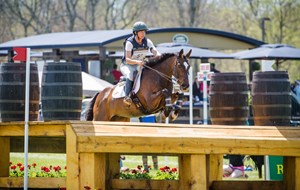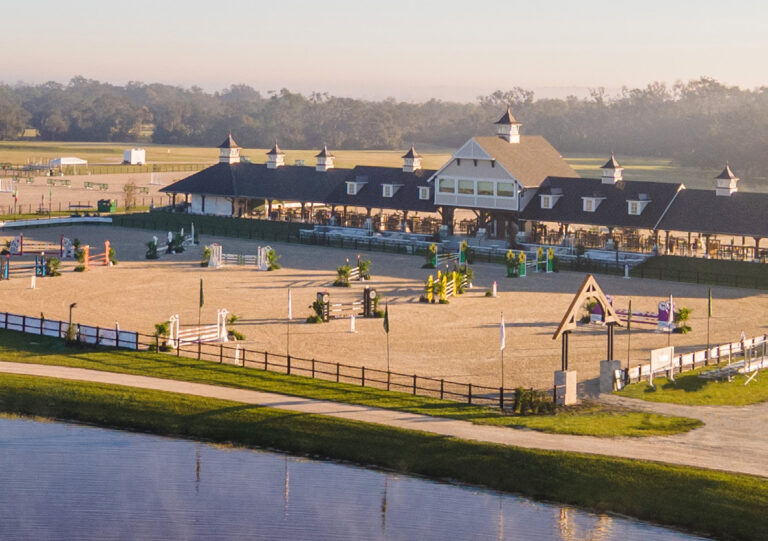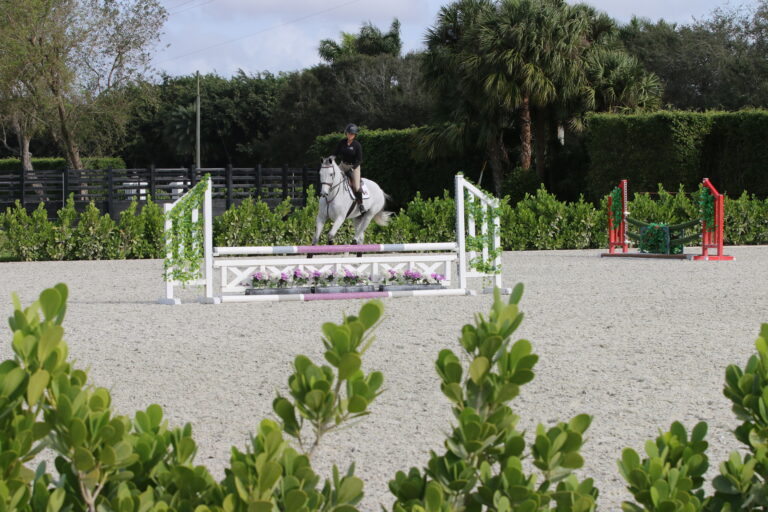In last month’s “Reaching for Rolex, Part I: Building Partnerships,” we introduced you to three first-time finishers of the Rolex Kentucky Three-Day Event with very busy “other” lives and very different equine partners: North Carolina businesswoman Rachel Jurgens and her 18-year-old off-the-track Thoroughbred Ziggy, Pennsylvania veterinarian Kevin Keane and his Irish Sport Horse Fernhill Flutter, and California Morgan Horse trainer Jennifer McFall and High Times (Billy), her American Holsteiner. Each described the process of making the CCI**** a goal, and the planning and preparation that went into actually arriving at Lexington’s Kentucky Horse Park in late April as a competitor.
This month, we’ll share the weekend of the event with our trio: What played out as they envisioned, what didn’t and whether each is contemplating another four-star go.
Rachel Jurgens: “It Was Fun—Toward the End”
 © Shannon Brinkman
© Shannon BrinkmanWhen I walked Derek di Grazia’s Rolex course for the first time this year, my impressions were a contrast to the way I had felt when walking the 2013 course, which Ziggy and I did not complete. In 2013, the course scared me to death. This year, I felt the outcome was going to be better. After that first walk I thought, “That feels good for Ziggy and me.” I didn’t worry about or doubt anything. I knew we could stumble or trip, but I really believed in him this year.
However good it felt, though, as I thought about each combination, I was like, “Wow, as soon as you get done with one, you can’t celebrate. You have to start thinking about the next one!” I was a little concerned about whether my brain and my horse could maintain that intensity all the way around the course.
Before cross country, however, we had to deal with dressage. When our turn came for our test on Thursday, our 70.5 score may have reflected—at least in part—the fact that I don’t even have a ring at home—we do all our flatwork out in big fields or on the dirt road. It’s too bad because Ziggy is a lovely mover on the flat. He just never gets to show it. (I did also hear from a couple of knowledgeable people that they thought the first day’s scoring was very tough.)
Once we were on the cross-country course two days later, my confidence increased each time Ziggy jumped a combination. I made a few mistakes, but he was flawless. He kept answering the questions better and better. I did get a little nervous when we were held at Fence 4, the Stick Pile, because I didn’t know how well he’d get going after having to stop. That was the one moment of the day where I thought, “Uh-oh, now what do I do?” But he set right back out and picked up his gallop. He was really there for me.
I never stopped my watch for the hold, so I had no idea where we were time-wise after that. We took the long option at a couple of jumps so we picked up 2.8 time penalties, but otherwise we jumped around clean. I was so proud of Ziggy for the way he galloped and jumped. It really was fun—toward the end!
After the elation of our cross-country round came Sunday and stadium jumping, which is our worst phase by a mile. I am always so impressed with people who can go in and put in beautiful clean show-jumping rounds because that is a work of art, and I’m just not there. My plan leading up to Rolex had been to do more jumper shows with Ziggy this past winter. It would’ve helped us to get into the ring and jump more because it’s something I don’t do enough of, but it just never worked out. Bless my occasional coach Bobby Costello’s heart for saying, “This is just the icing on the cake, Rachel. Don’t worry about it—you’re already here.” It was an impressive ring to canter down into, and it was packed with people so you could be sure to make mistakes right in front of everyone. We did make mistakes, but even though we had five rails, it really helped to think about it as Bobby suggested. I was happy to finish 27th.
So, what next? Ziggy doesn’t want to be retired. He doesn’t want to stand around. I’d like to find someone who would love what he has to offer. He’s so simple, so easy to ride. He could take someone—a Young Rider, for instance—Intermediate, help her do her first Advanced. Meanwhile, I have two of Ziggy’s younger half-brothers, also off the track. They were getting lots of work until a month or two before Rolex, when I chucked them out in the field and said, “Sorry, guys, you’re on the low end of the totem pole right now.”
I’d like to bring them along. I’m not sure I aspire to do Rolex again because of the financial commitment, not to mention the sheer amount of time and work involved. As of now, I don’t know whether Ziggy’s brothers are as talented. Everyone says, “How about if one of them is another Ziggy? Would you go back to Kentucky?” Today I’d say no … but you never know when that bug will bite.
Kevin: “The Possibility is There”
 © Shannon Brinkman
© Shannon BrinkmanI had been at Rolex as a veterinarian for 20 years, and I found myself still filling that role on a consulting basis even when I was there as a competitor this year. Several of my friends who were competing had some issues with their horses, and I was busy helping as I could. Phillip Dutton, who is usually my coach for all three phases, was riding three horses in the event. He’s very giving with his time, but I didn’t want to impose on him in these circumstances. Fortunately, he had arranged for Capt. Mark Phillips to help me in my dressage warm-up, and Capt. Phillips was phenomenal. In the 40 minutes he worked with me before we went into the ring, he helped me get Butterfly really “over his back.” I was thrilled because my horse has quite a soft mouth and tends to get short in his neck during the collected work. I wasn’t at all nervous going into the ring for my dressage test. As I am in the large group of eventers for whom dressage is particularly challenging, I was very pleased with our score of 59.2.
Because I had been so busy with veterinary consulting, however, by 5:15 p.m. Thursday I still had not walked the cross-country course even once. There had just been no time to do it, and I was starting to get anxious. Phillip and I walked it shortly after that. His overall advice was, “I don’t care how many times you need to walk it, you must absolutely own this course.” He meant that I needed to know which part of the galloping lane to be on each foot of the way to minimize the length of the track. He also said, “You’ve got to have your line correct, and you have to have the correct canter going to the jump.” A wide turn can add a second or two to the approach to a fence, and in 45 jumping efforts that can add a lot of time.
I walked the course several times by myself on Friday, then once again on Saturday morning with Boyd Martin, who was sidelined with an injury, and two of his students. As I got the course firmly in my mind, I kept mentally tracking the path I would take in a given place to keep Butterfly and myself on either the lane’s right rope, the left rope or in the center to keep the distance down as much as possible. Boyd pointed out that at Fence 6, a massive oxer, you got on a very good line for Fence 7, the Park Question, if you didn’t turn into the rope too quickly after landing. That’s exactly how I rode it and it worked nicely.
Each time I walked the course, I was struck by how Derek di Grazia doesn’t want you taking back on your horse—he rewards a forward approach. There also wasn’t a let-up fence anywhere—each asked a question. I think one fence that might have surprised some competitors was the coffin jump at Fence 7, which turned out to require quite a forward ride all the way through. Fortunately I had gotten to see a couple of horses go before I started and had noticed that I needed a bigger step than the compressed “coffin canter” we often associate with this kind of question.
It was such a feeling of exhilaration to gallop across that finish line. Butterfly never felt tired. He was strong right to the end. I felt proud that the 11-1/2 minutes of galloping and jumping was well within his fitness. We had added 30 penalty points to our score at Fence 14ABC (the Land Rover Hollow) when after jumping A well and taking the direct line to B, Butterfly hit the flag of the B element with his left shoulder. I immediately re-routed to the option, but I had started the direct route before making the change—20 penalty points. Of course, taking the longer option at that point took extra time so we also incurred some time faults, but completion of our first four-star was within reach.
On stadium day I was struck by how little time we riders had to study the show-jumping course. Because of all the morning’s other activities, beginning with the Second Horse Inspection and including the competitors’ parade, I had about 20 minutes to walk the course and get it into my head. I realized I needed to have my eyes up to know where I was going at every fence and to have my line right. Of course I wanted a clean round—Butterfly had had only one rail down all year at our horse trials. He was very rideable and did all the fences in a nice rhythm, jumping even better as the course went on, but we did have two rails down for a final score of 97.2, which put us in 28th place.
The one thing I’m hoping will result from my experience at Rolex is to show other people that if you want to do it badly enough, the possibility is there. You may have to give up other things in your life, but if you can hook up with the right equine partner and you’re with the right training program, you can realize the dream. I turned 60 this summer and I’ve been hearing that 60 is the new 40. That’s an attitude to take with you if you dream of doing the sport at this level as a mature adult. If you won’t let anything get in your way, you can succeed.
I’m planning to go to Fair Hill International CCI*** this fall, allowing Butterfly to drop back a level and run over another Derek di Grazia course at a beautiful galloping venue. Then, we’ll see if we can get back to Rolex in 2015.
Jennifer McFall: “WE Can’t Wait to be Back”
 © Shannon Brinkman
© Shannon BrinkmanPhysically getting to Rolex from California was nearly as big a challenge as the competition itself. Billy was set to fly out to Kentucky with Gin N Juice and The Alchemist (the horses my coach, Hawley Bennett, and California rider Debbie Rosen, would be riding in the four-star); my husband, Earl, and I, with our 11-year-old daughter, Taylor, were to drive out the rig that would bring all our horses back to California after the competition.
The final Saturday morning before the show, Earl, Taylor and I hopped in our truck and started the drive to Kentucky while Hawley and her crew graciously took care of Billy. Our plan was to meet Hawley and the horses at the airport in Lexington, Kentucky, and bring them to the Horse Park on Monday at noon. Our schedule became very tight after some persuasive whining from us girls convinced Earl that we needed hotel beds, not the midnight naps in a truck-stop parking lot that he had envisioned. We arrived at the airport without a minute to spare, making it in time to see Billy deplane for the first time in his career.
Wednesday was exciting with the opening of the cross-country course and also our first four-star jog. My initial walk of the course was with Earl, Taylor and my brother, Jon. Although I was prepared to see a difficult course, the sheer size of the fences and ditches still impressed me. Luckily the fear of being teased by my big brother, even in old age, is strong so I kept my mouth shut and reminded myself that the first time you walk a course is always the worst. Then it was on to the official start of the competition. With a borrowed dress from Coach Hawley and the most sparkling and glamorous version of Billy courtesy of my Super-Groom, Sophia Zeier, Billy and I headed to our First Horse Inspection. I admit that I had little faith in our ability to produce a classy, controlled jog. Billy has a reputation as a “foot stomper” at our farm, especially when there are fun things to spook at. But he loved both the crowds and the oodles of photographers and stayed well clear of my scantily clad feet while modeling his good looks for the ground jury.
My dressage test was Friday, but Thursday will forever go down in my memory as one of the best because of one shining moment: I was riding Billy away from the stadium after our turn at ring familiarization when he startled as someone trotted up behind us. On my left, a gentleman apologized and asked if he could please walk back with me. I turned to see William Fox-Pitt and his soon-to-be-winning mount, Bay My Hero. Ummmm … YES! (I have an admitted crush on WFP and he has been the unknowing subject of my profile pic on Facebook more than once). William—we are on a first-name basis—spoke of how handsome my horse was and asked MY opinion on some of the cross-country lines. Well, sure, I’d love to give you some advice on how to ride on Saturday! It was a thrilling 10 minutes for me even if he was just making polite conversation with a rookie because he needed a lead for his horse.
Friday’s dressage was almost as exciting as riding with William Fox-Pitt, simply because I was in the Rolex stadium with Billy. Our score (71.5) was nothing to write home about, but I was pleased that he mostly kept his feet on the ground. We were set to compete the next day on that famous blue grass.
Although I was in a good mental space on Saturday, the anticipation was unbearable. As number 66, I rode at the end of a very long day that was full of trouble on Derek’s tough course. Waiting for my turn and seeing others’ mishaps was so exhausting that I actually had to take a nap in the truck before my ride.
Once our ride time was upon us and I was on Billy, it was simply time to get our job done. The warm-up was oddly calm for him but he was jumping in good form, and when I walked down to the box he got his usual fire cooking. Knowing that I was about to start my first four-star cross country was unnerving. Opposing thoughts of “I am doing this!” and “Am I really doing this?” pulled each other in my mind until, mercifully, the timer said we were off.
The course itself was pure joy to ride. Billy and I went out as a purposeful, willing and eager team and came back exactly the same but with a four-star cross-country course under our belts. The sense of accomplishment and gratitude for my horse, family and loved ones was so poignant, it made even me, a non-crier, feel a little teary-eyed. Of course, Billy could never know that he made me believe in myself and gave me the courage to try this. But I do think he knows that we are partners for life and that I would do anything in my power not to let him down, just as he does for me.
Being back in the Rolex stadium on Sunday was a new sensation of its own: I was so happy to be in the position to complete the Rolex Kentucky CCI**** that I truly had no nerves going in and performing in front of the sold-out audience. Billy was prouder than ever when the crowd cheered him on, his ego growing exponentially with every fan he gained throughout the course. We finished in 36th place, and I think I can safely say WE can’t wait to be back in 2015!
This article originally appeared in the September 2014 issue of Practical Horseman.











